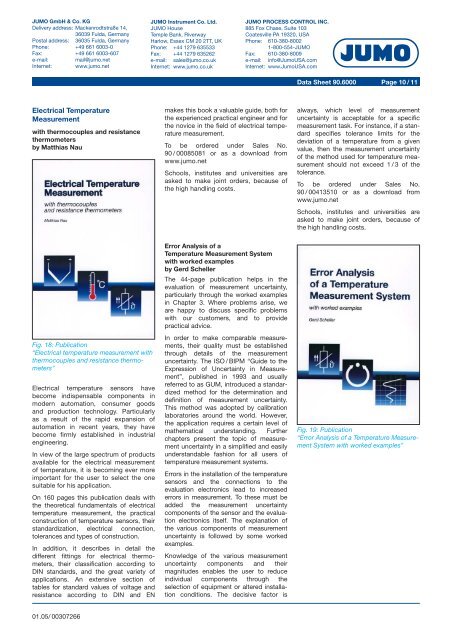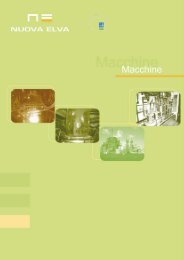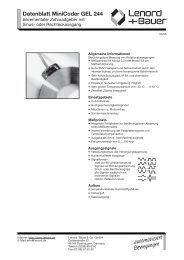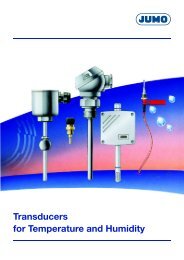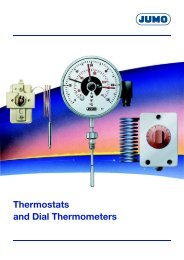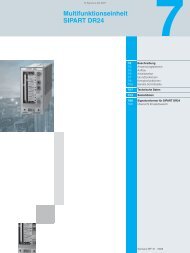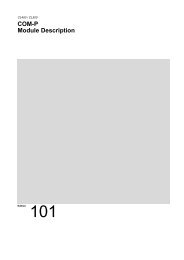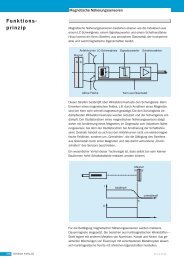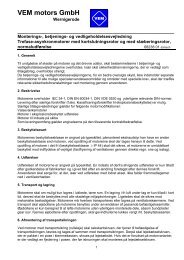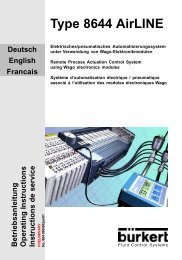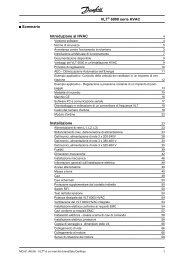Platinum Temperature Sensors - Nuova Elva
Platinum Temperature Sensors - Nuova Elva
Platinum Temperature Sensors - Nuova Elva
You also want an ePaper? Increase the reach of your titles
YUMPU automatically turns print PDFs into web optimized ePapers that Google loves.
JUMO GmbH & Co. KG<br />
Delivery address: Mackenrodtstraße 14,<br />
36039 Fulda, Germany<br />
Postal address: 36035 Fulda, Germany<br />
Phone: +49 661 6003-0<br />
Fax: +49 661 6003-607<br />
e-mail:<br />
mail@jumo.net<br />
Internet: www.jumo.net<br />
JUMO Instrument Co. Ltd.<br />
JUMO House<br />
Temple Bank, Riverway<br />
Harlow, Essex CM 20 2TT, UK<br />
Phone: +44 1279 635533<br />
Fax: +44 1279 635262<br />
e-mail: sales@jumo.co.uk<br />
Internet: www.jumo.co.uk<br />
JUMO PROCESS CONTROL INC.<br />
885 Fox Chase, Suite 103<br />
Coatesville PA 19320, USA<br />
Phone: 610-380-8002<br />
1-800-554-JUMO<br />
Fax: 610-380-8009<br />
e-mail: info@JumoUSA.com<br />
Internet: www.JumoUSA.com<br />
Data Sheet 90.6000 Page 10 / 11<br />
Electrical <strong>Temperature</strong><br />
Measurement<br />
with thermocouples and resistance<br />
thermometers<br />
by Matthias Nau<br />
makes this book a valuable guide, both for<br />
the experienced practical engineer and for<br />
the novice in the field of electrical temperature<br />
measurement.<br />
To be ordered under Sales No.<br />
90 / 00085081 or as a download from<br />
www.jumo.net<br />
Schools, institutes and universities are<br />
asked to make joint orders, because of<br />
the high handling costs.<br />
always, which level of measurement<br />
uncertainty is acceptable for a specific<br />
measurement task. For instance, if a standard<br />
specifies tolerance limits for the<br />
deviation of a temperature from a given<br />
value, then the measurement uncertainty<br />
of the method used for temperature measurement<br />
should not exceed 1 / 3 of the<br />
tolerance.<br />
To be ordered under Sales No.<br />
90 / 00413510 or as a download from<br />
www.jumo.net<br />
Schools, institutes and universities are<br />
asked to make joint orders, because of<br />
the high handling costs.<br />
Fig. 18: Publication<br />
“Electrical temperature measurement with<br />
thermocouples and resistance thermometers”<br />
Electrical temperature sensors have<br />
become indispensable components in<br />
modern automation, consumer goods<br />
and production technology. Particularly<br />
as a result of the rapid expansion of<br />
automation in recent years, they have<br />
become firmly established in industrial<br />
engineering.<br />
In view of the large spectrum of products<br />
available for the electrical measurement<br />
of temperature, it is becoming ever more<br />
important for the user to select the one<br />
suitable for his application.<br />
On 160 pages this publication deals with<br />
the theoretical fundamentals of electrical<br />
temperature measurement, the practical<br />
construction of temperature sensors, their<br />
standardization, electrical connection,<br />
tolerances and types of construction.<br />
In addition, it describes in detail the<br />
different fittings for electrical thermometers,<br />
their classification according to<br />
DIN standards, and the great variety of<br />
applications. An extensive section of<br />
tables for standard values of voltage and<br />
resistance according to DIN and EN<br />
Error Analysis of a<br />
<strong>Temperature</strong> Measurement System<br />
with worked examples<br />
by Gerd Scheller<br />
The 44-page publication helps in the<br />
evaluation of measurement uncertainty,<br />
particularly through the worked examples<br />
in Chapter 3. Where problems arise, we<br />
are happy to discuss specific problems<br />
with our customers, and to provide<br />
practical advice.<br />
In order to make comparable measurements,<br />
their quality must be established<br />
through details of the measurement<br />
uncertainty. The ISO / BIPM “Guide to the<br />
Expression of Uncertainty in Measurement”,<br />
published in 1993 and usually<br />
referred to as GUM, introduced a standardized<br />
method for the determination and<br />
definition of measurement uncertainty.<br />
This method was adopted by calibration<br />
laboratories around the world. However,<br />
the application requires a certain level of<br />
mathematical understanding. Further<br />
chapters present the topic of measurement<br />
uncertainty in a simplified and easily<br />
understandable fashion for all users of<br />
temperature measurement systems.<br />
Errors in the installation of the temperature<br />
sensors and the connections to the<br />
evaluation electronics lead to increased<br />
errors in measurement. To these must be<br />
added the measurement uncertainty<br />
components of the sensor and the evaluation<br />
electronics itself. The explanation of<br />
the various components of measurement<br />
uncertainty is followed by some worked<br />
examples.<br />
Knowledge of the various measurement<br />
uncertainty components and their<br />
magnitudes enables the user to reduce<br />
individual components through the<br />
selection of equipment or altered installation<br />
conditions. The decisive factor is<br />
Fig. 19: Publication<br />
“Error Analysis of a <strong>Temperature</strong> Measurement<br />
System with worked examples”<br />
01.05/ 00307266


